The Cambridge History of Japan, Vol. 3: Medieval Japan
Подождите немного. Документ загружается.

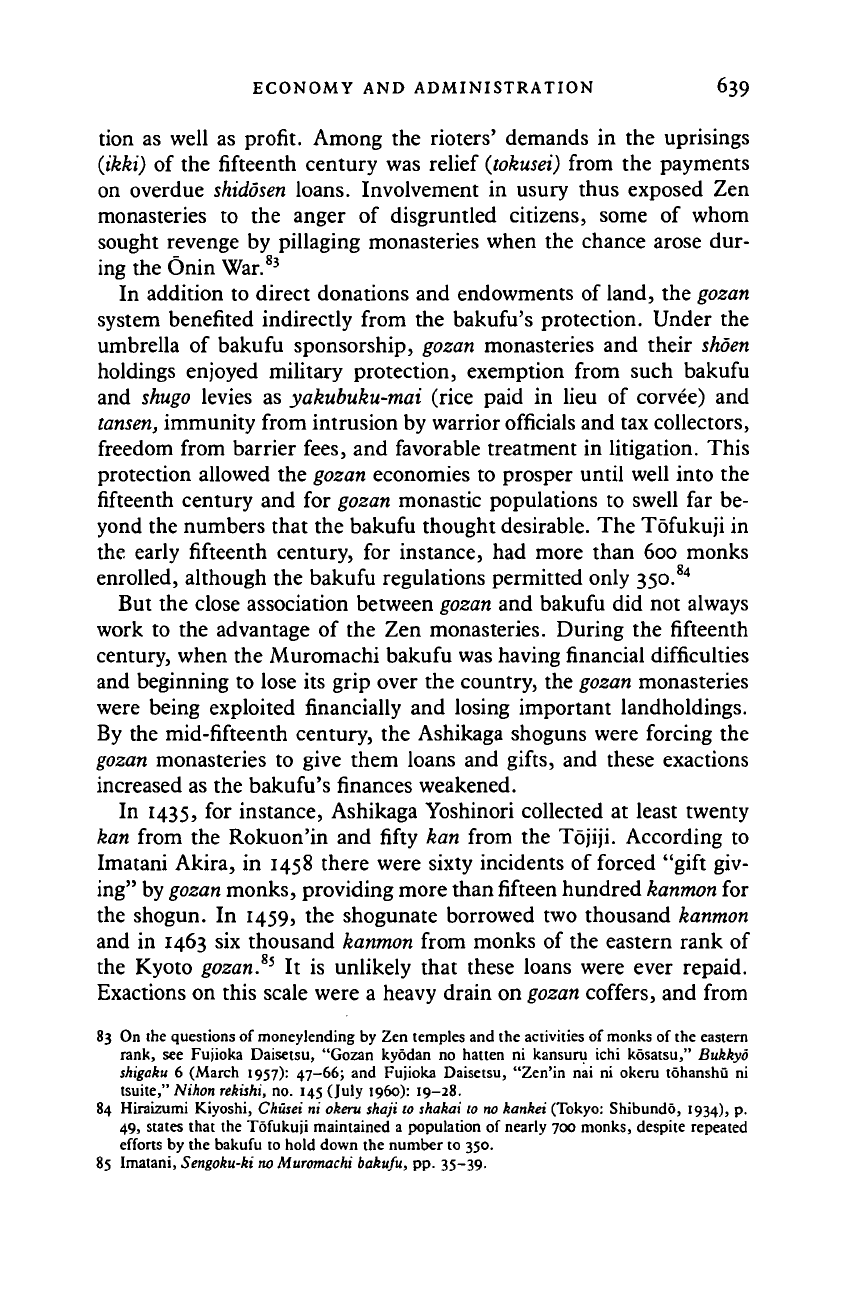
ECONOMY AND ADMINISTRATION 639
tion as well as profit. Among the rioters' demands in the uprisings
(ikki) of the fifteenth century was relief (tokusei) from the payments
on overdue shidosen loans. Involvement in usury thus exposed Zen
monasteries to the anger of disgruntled citizens, some of whom
sought revenge by pillaging monasteries when the chance arose dur-
ing the Onin War.
83
In addition to direct donations and endowments of land, the gozan
system benefited indirectly from the bakufu's protection. Under the
umbrella of bakufu sponsorship, gozan monasteries and their shoen
holdings enjoyed military protection, exemption from such bakufu
and shugo levies as yakubuku-mai (rice paid in lieu of corvee) and
tansen, immunity from intrusion by warrior officials and tax collectors,
freedom from barrier fees, and favorable treatment in litigation. This
protection allowed the gozan economies to prosper until well into the
fifteenth century and for gozan monastic populations to swell far be-
yond the numbers that the bakufu thought desirable. The Tofukuji in
the early fifteenth century, for instance, had more than 600 monks
enrolled, although the bakufu regulations permitted only 350.
84
But the close association between gozan and bakufu did not always
work to the advantage of the Zen monasteries. During the fifteenth
century, when the Muromachi bakufu was having financial difficulties
and beginning to lose its grip over the country, the gozan monasteries
were being exploited financially and losing important landholdings.
By the mid-fifteenth century, the Ashikaga shoguns were forcing the
gozan monasteries to give them loans and gifts, and these exactions
increased as the bakufu's finances weakened.
In 1435, for instance, Ashikaga Yoshinori collected at least twenty
kan from the Rokuon'in and fifty kan from the Tojiji. According to
Imatani Akira, in 1458 there were sixty incidents of forced "gift giv-
ing" by gozan monks, providing more than fifteen hundred kanmon for
the shogun. In 1459, the shogunate borrowed two thousand kanmon
and in 1463 six thousand kanmon from monks of the eastern rank of
the Kyoto gozan.
85
It is unlikely that these loans were ever repaid.
Exactions on this scale were a heavy drain on gozan coffers, and from
83 On the questions of moneylending by Zen temples and the activities of monks of the eastern
rank, see Fujioka Daisetsu, "Gozan kyodan no hatten ni kansuru ichi kosatsu," Bukkyo
shigaku 6 (March 1957): 47-66; and Fujioka Daisetsu, "Zen'in nai ni okeru tohanshu ni
tsuite," Nihon rekishi, no. 145 (July i960): 19-28.
84 Hiraizumi Kiyoshi, Chusei ni okeru shaji to shakai to no kankei (Tokyo: Shibundo, 1934), p.
49,
states that the Tofukuji maintained a population of nearly 700 monks, despite repeated
efforts by the bakufu to hold down the number to 350.
85 Imatani, Sengoku-ki no Muromachi bakufu, pp. 35-39.
Cambridge Histories Online © Cambridge University Press, 2008

640 ZEN AND THE GOZAN
the 1460s, gozan monk administrators protested that they could no
longer afford to make loans to the shogunate.
Moreover, the wealth that the
gozan
monasteries had derived from
their extensive shoen holding was drastically reduced when, fron:
around the time of the Onin War, the bakufu began to disallow exemp-
tions from
yakubuku-mai
and
tansen
levies and the local warriors began
to intrude with impunity into gozan landholdings. In the spreading
provincial disorder of the late fifteenth and sixteenth centuries,
gozan
monasteries like the Tenryuji, Nanzenji, Engakuji, and Rinsenji lost
control over most of their
shoen
holdings. This continued until Oda
Nobunaga and Toyotomi Hideyoshi restored order to the provinces
and began to rebuild the stricken
gozan
monasteries, restoring, though
on a much smaller scale, their economic base. In 1591, for instance,
Hideyoshi confirmed the Nanzenji's holdings in and around Kyoto,
with an income of 592 koku. Tokugawa Ieyasu later raised this to 892
koku.*
6
This income was probably sufficient to support a community
of several hundred, but it was a far cry from the more than 4,000
koku
that the Nanzenji had received from its landholdings in the late four-
teenth century.
Whereas the economies of the
gozan
monasteries generally traced a
parabola of growth through the thirteenth, fourteenth, and early fif-
teenth centuries, followed by disintegration in the late fifteenth and
sixteenth centuries, the economies of the Daio branches of Rinzai Zen
and the Soto monasteries followed a contrary curve, coming into their
own as the
gozan
declined.
In the late fourteenth century, none of the leading
non-gozan
Rinzai
or Soto monasteries - Daitokuji, Myoshinji, Eiheiji, and Sojiji -
compared in wealth with their
gozan
counterparts. The Daitokuji had
fared well under the patronage of Godaigo in the early 1330s. It was
granted full control and immunity
(ichienfuyu)
over six
shoen
and from
one of them, Tomono-no-sho in Shinano Province, derived (if the
documents can be believed) the enormous income of
7,600
koku.
87
The
Daitokuji did not, however, find favor with the Ashikaga, and without
the shogun's support, the monastery found it difficult to hold on to its
scattered
shoen
holdings during the civil wars of the fourteenth cen-
tury. In
1371,
the Daitokuji appears to have received an income of only
433
kannton
from two
shorn.™
This was sufficient to sustain a commu-
nity of thirty or so monks and attendants, in contrast with the more
86 Nanzenji monjo, vol. 2, docs. 303, 378, 384.
87 Daitokuji monjo, vol. I, doc. 25 and vol. 2, doc. 643. 88 Dailokuji
monjo,
vol. 1, doc. 124.
Cambridge Histories Online © Cambridge University Press, 2008
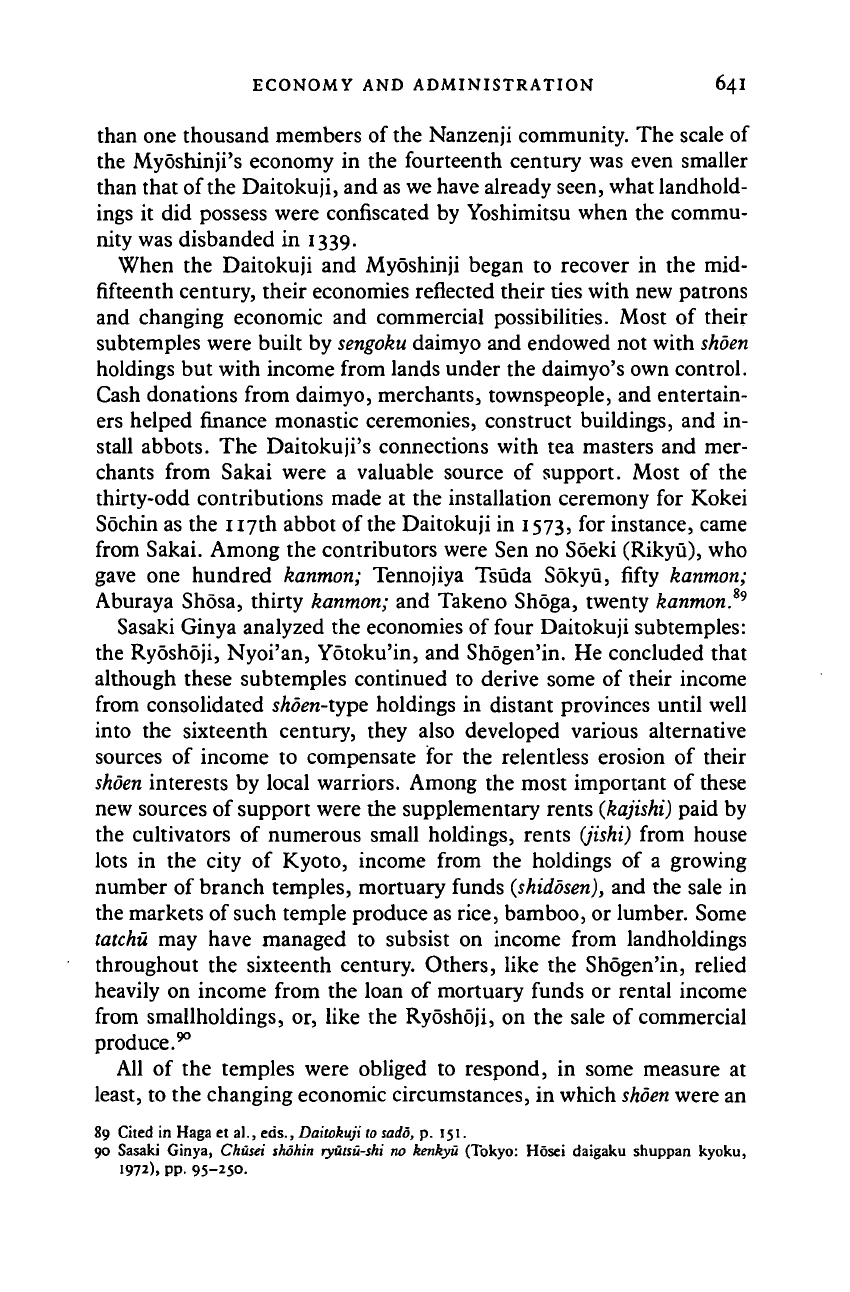
ECONOMY AND ADMINISTRATION 64I
than one thousand members of the Nanzenji community. The scale of
the Myoshinji's economy in the fourteenth century was even smaller
than that of the Daitokuji, and as we have already seen, what landhold-
ings it did possess were confiscated by Yoshimitsu when the commu-
nity was disbanded in 1339.
When the Daitokuji and Myoshinji began to recover in the mid-
fifteenth century, their economies reflected their ties with new patrons
and changing economic and commercial possibilities. Most of their
subtemples were built by
sengoku
daimyo and endowed not with shoen
holdings but with income from lands under the daimyo's own control.
Cash donations from daimyo, merchants, townspeople, and entertain-
ers helped finance monastic ceremonies, construct buildings, and in-
stall abbots. The Daitokuji's connections with tea masters and mer-
chants from Sakai were a valuable source of support. Most of the
thirty-odd contributions made at the installation ceremony for Kokei
Sochin as the 117th abbot of the Daitokuji in 1573, for instance, came
from Sakai. Among the contributors were Sen no Soeki (Rikyu), who
gave one hundred kanmon; Tennojiya Tsuda Sokyu, fifty kanmon;
Aburaya Shosa, thirty kanmon; and Takeno Shoga, twenty kanmon}
9
Sasaki Ginya analyzed the economies of four Daitokuji subtemples:
the Ryoshoji, Nyoi'an, Yotoku'in, and Shogen'in. He concluded that
although these subtemples continued to derive some of their income
from consolidated shden-type holdings in distant provinces until well
into the sixteenth century, they also developed various alternative
sources of income to compensate for the relentless erosion of their
shoen interests by local warriors. Among the most important of these
new sources of support were the supplementary rents (kajishi) paid by
the cultivators of numerous small holdings, rents (jishi) from house
lots in the city of Kyoto, income from the holdings of a growing
number of branch temples, mortuary funds (shidosen), and the sale in
the markets of such temple produce as rice, bamboo, or lumber. Some
tatchu may have managed to subsist on income from landholdings
throughout the sixteenth century. Others, like the Shogen'in, relied
heavily on income from the loan of mortuary funds or rental income
from smallholdings, or, like the Ryoshoji, on the sale of commercial
produce.
90
All of the temples were obliged to respond, in some measure at
least, to the changing economic circumstances, in which
shoen
were an
89 Cited in Haga et al., eds., Daitokuji to
sadd,
p. 151.
90 Sasaki Ginya, Chusei skohin ryutsu-shi no kenkyu (Tokyo: Hosei daigaku shuppan kyoku,
PP-
95-25O.
Cambridge Histories Online © Cambridge University Press, 2008
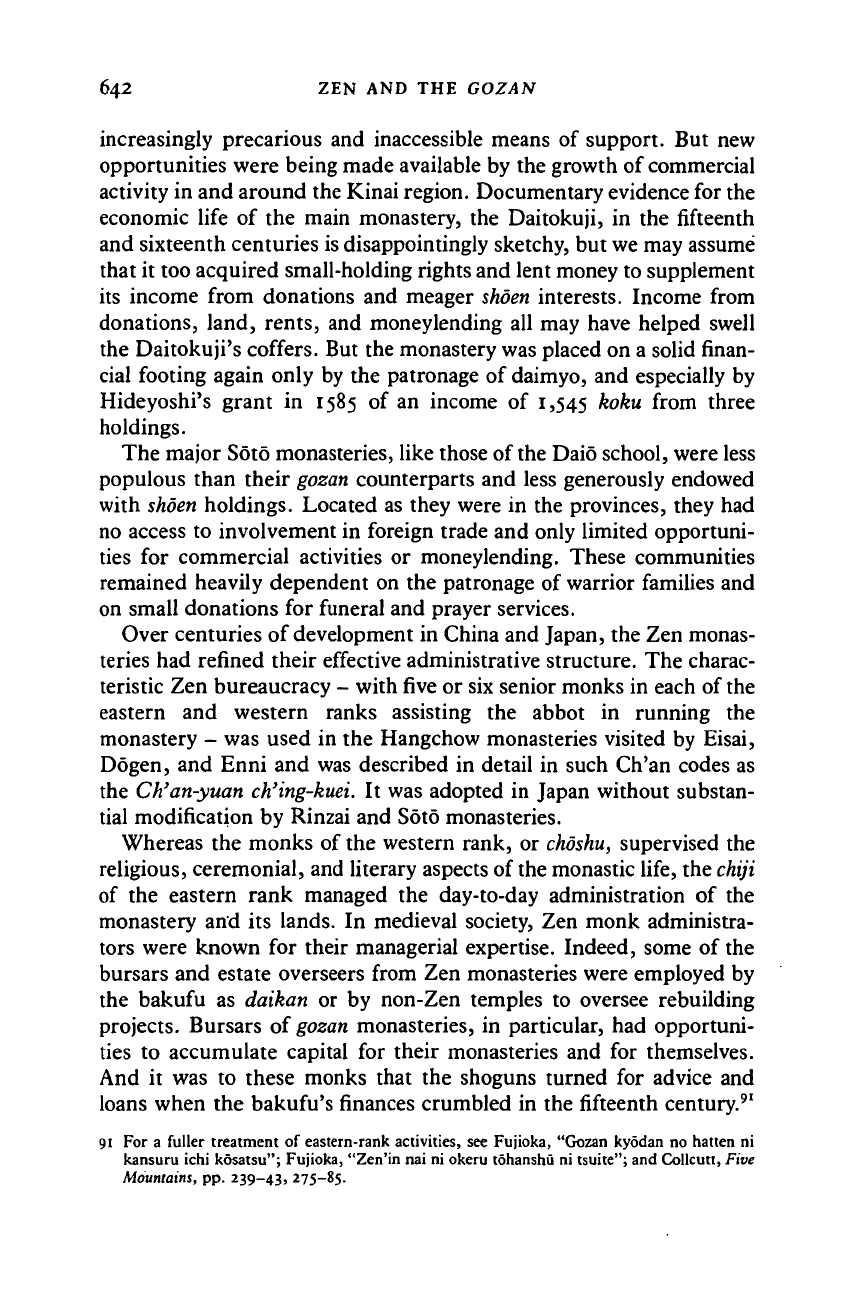
642 ZEN AND THE GOZAN
increasingly precarious and inaccessible means of support. But new
opportunities were being made available by the growth of commercial
activity in and around the Kinai region. Documentary evidence for the
economic life of the main monastery, the Daitokuji, in the fifteenth
and sixteenth centuries is disappointingly sketchy, but we may assume
that it too acquired small-holding rights and lent money to supplement
its income from donations and meager
shoen
interests. Income from
donations, land, rents, and moneylending all may have helped swell
the Daitokuji's coffers. But the monastery was placed on a solid finan-
cial footing again only by the patronage of daimyo, and especially by
Hideyoshi's grant in 1585 of an income of 1,545 koku from three
holdings.
The major Soto monasteries, like those of the Daio school, were less
populous than their
gozan
counterparts and less generously endowed
with
shoen
holdings. Located as they were in the provinces, they had
no access to involvement in foreign trade and only limited opportuni-
ties for commercial activities or moneylending. These communities
remained heavily dependent on the patronage of warrior families and
on small donations for funeral and prayer services.
Over centuries of development in China and Japan, the Zen monas-
teries had refined their effective administrative structure. The charac-
teristic Zen bureaucracy - with five or six senior monks in each of the
eastern and western ranks assisting the abbot in running the
monastery - was used in the Hangchow monasteries visited by Eisai,
Dogen, and Enni and was described in detail in such Ch'an codes as
the Ch'an-yuan
ch'ing-kuei.
It was adopted in Japan without substan-
tial modification by Rinzai and Soto monasteries.
Whereas the monks of the western rank, or
choshu,
supervised the
religious, ceremonial, and literary aspects of the monastic life, the
chiji
of the eastern rank managed the day-to-day administration of the
monastery and its lands. In medieval society, Zen monk administra-
tors were known for their managerial expertise. Indeed, some of the
bursars and estate overseers from Zen monasteries were employed by
the bakufu as daikan or by non-Zen temples to oversee rebuilding
projects. Bursars of
gozan
monasteries, in particular, had opportuni-
ties to accumulate capital for their monasteries and for themselves.
And it was to these monks that the shoguns turned for advice and
loans when the bakufu's finances crumbled in the fifteenth century.
9
'
91 For a fuller treatment of eastern-rank activities, see Fujioka, "Gozan kyodan no hatten ni
kansuru ichi kdsatsu"; Fujioka, "Zen'in nai ni okeru tohanshu ni tsuite"; and Collcutt, Five
Mountains, pp. 239-43,
2
75—
8
5-
Cambridge Histories Online © Cambridge University Press, 2008
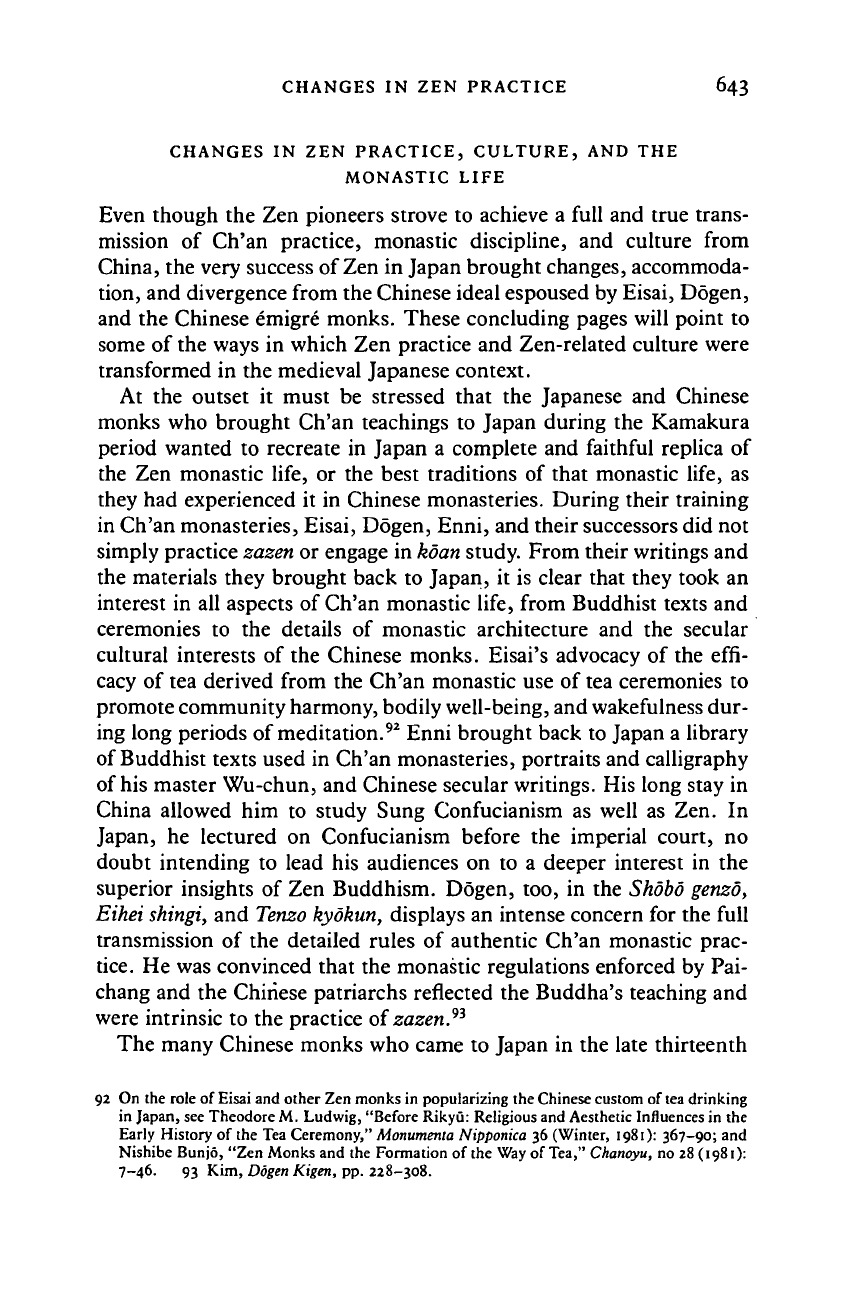
CHANGES IN ZEN PRACTICE 643
CHANGES IN ZEN PRACTICE, CULTURE, AND THE
MONASTIC LIFE
Even though the Zen pioneers strove to achieve a full and true trans-
mission of Ch'an practice, monastic discipline, and culture from
China, the very success of Zen in Japan brought changes, accommoda-
tion, and divergence from the Chinese ideal espoused by Eisai, Ddgen,
and the Chinese emigre monks. These concluding pages will point to
some of the ways in which Zen practice and Zen-related culture were
transformed in the medieval Japanese context.
At the outset it must be stressed that the Japanese and Chinese
monks who brought Ch'an teachings to Japan during the Kamakura
period wanted to recreate in Japan a complete and faithful replica of
the Zen monastic life, or the best traditions of that monastic life, as
they had experienced it in Chinese monasteries. During their training
in Ch'an monasteries, Eisai, Dogen, Enni, and their successors did not
simply practice zazen or engage in koan study. From their writings and
the materials they brought back to Japan, it is clear that they took an
interest in all aspects of Ch'an monastic life, from Buddhist texts and
ceremonies to the details of monastic architecture and the secular
cultural interests of the Chinese monks. Eisai's advocacy of the effi-
cacy of tea derived from the Ch'an monastic use of tea ceremonies to
promote community harmony, bodily well-being, and wakefulness dur-
ing long periods of meditation.
92
Enni brought back to Japan a library
of Buddhist texts used in Ch'an monasteries, portraits and calligraphy
of his master Wu-chun, and Chinese secular writings. His long stay in
China allowed him to study Sung Confucianism as well as Zen. In
Japan, he lectured on Confucianism before the imperial court, no
doubt intending to lead his audiences on to a deeper interest in the
superior insights of Zen Buddhism. Dogen, too, in the Shobo genzo,
Eihei shingi, and Tenzo kyokun, displays an intense concern for the full
transmission of the detailed rules of authentic Ch'an monastic prac-
tice.
He was convinced that the monastic regulations enforced by Pai-
chang and the Chinese patriarchs reflected the Buddha's teaching and
were intrinsic to the practice of zazen.
9i
The many Chinese monks who came to Japan in the late thirteenth
92 On the role of Eisai and other Zen monks in popularizing the Chinese custom of tea drinking
in Japan, see Theodore M. Ludwig, "Before Rikyu: Religious and Aesthetic Influences in the
Early History of the Tea Ceremony," Monumenta Nipponica 36 (Winter, 1981): 367-90; and
Nishibe Bunjo, "Zen Monks and the Formation of the Way of Tea," Chanoyu, no 28 (1981):
7-46. 93 Kim, Dogen Kigen, pp. 228-308.
Cambridge Histories Online © Cambridge University Press, 2008
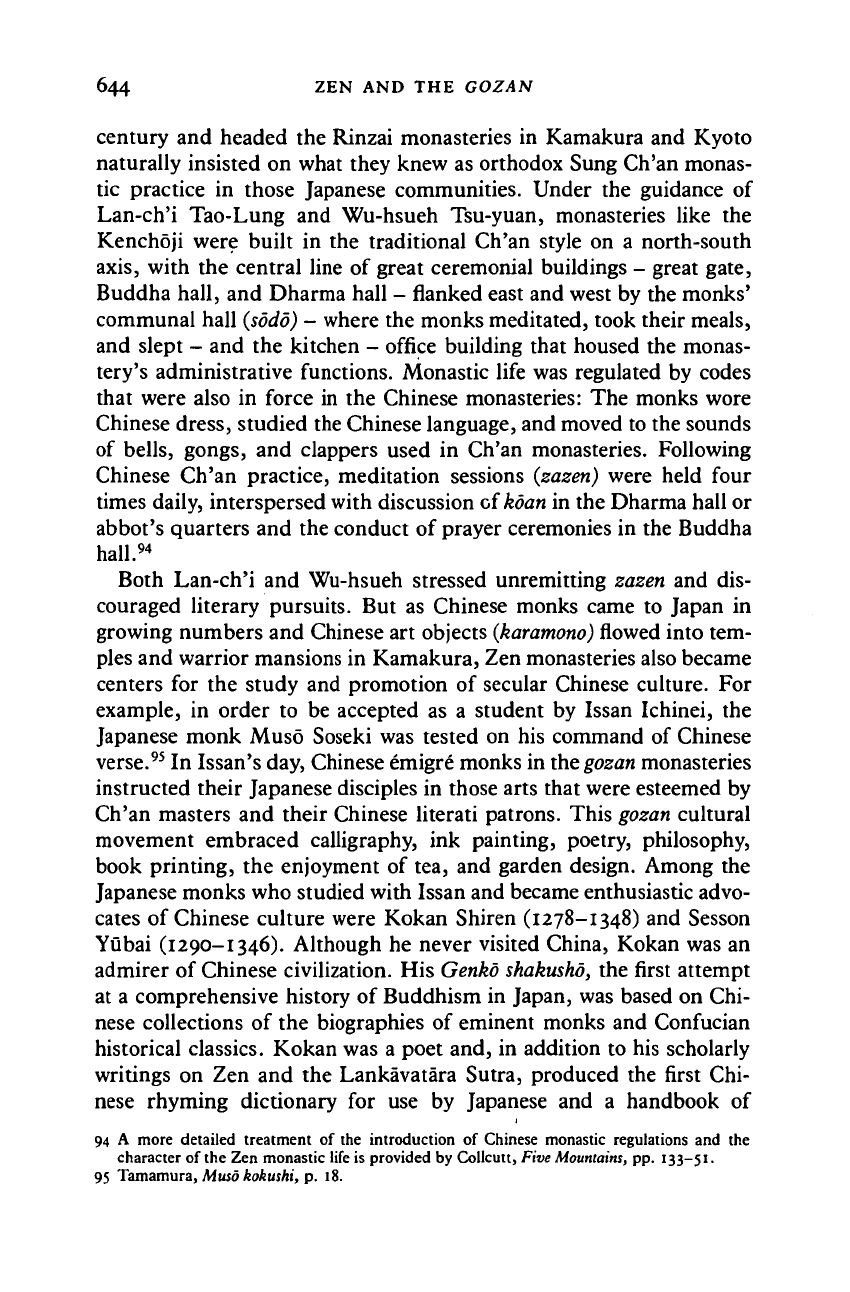
644 ZEN AND THE GOZAN
century and headed the Rinzai monasteries in Kamakura and Kyoto
naturally insisted on what they knew as orthodox Sung Ch'an monas-
tic practice in those Japanese communities. Under the guidance of
Lan-ch'i Tao-Lung and Wu-hsueh Tsu-yuan, monasteries like the
Kenchoji were built in the traditional Ch'an style on a north-south
axis,
with the central line of great ceremonial buildings - great gate,
Buddha hall, and Dharma hall - flanked east and west by the monks'
communal hall
(sodo)
- where the monks meditated, took their meals,
and slept - and the kitchen - office building that housed the monas-
tery's administrative functions. Monastic life was regulated by codes
that were also in force in the Chinese monasteries: The monks wore
Chinese dress, studied the Chinese language, and moved to the sounds
of bells, gongs, and clappers used in Ch'an monasteries. Following
Chinese Ch'an practice, meditation sessions (zazen) were held four
times daily, interspersed with discussion cf
koan
in the Dharma hall or
abbot's quarters and the conduct of prayer ceremonies in the Buddha
hall.
94
Both Lan-ch'i and Wu-hsueh stressed unremitting zazen and dis-
couraged literary pursuits. But as Chinese monks came to Japan in
growing numbers and Chinese art objects
(karamono)
flowed
into tem-
ples and warrior mansions in Kamakura, Zen monasteries also became
centers for the study and promotion of secular Chinese culture. For
example, in order to be accepted as a student by Issan Ichinei, the
Japanese monk Muso Soseki was tested on his command of Chinese
verse.
95
In Issan's day, Chinese emigre monks in the
gozan
monasteries
instructed their Japanese disciples in those arts that were esteemed by
Ch'an masters and their Chinese literati patrons. This
gozan
cultural
movement embraced calligraphy, ink painting, poetry, philosophy,
book printing, the enjoyment of tea, and garden design. Among the
Japanese monks who studied with Issan and became enthusiastic advo-
cates of Chinese culture were Kokan Shiren (1278-1348) and Sesson
Yubai (1290-1346). Although he never visited China, Kokan was an
admirer of Chinese civilization. His
Genko
shakusho,
the first attempt
at a comprehensive history of Buddhism in Japan, was based on Chi-
nese collections of the biographies of eminent monks and Confucian
historical classics. Kokan was a poet and, in addition to his scholarly
writings on Zen and the Lankavatara Sutra, produced the first Chi-
nese rhyming dictionary for use by Japanese and a handbook of
94
A
more detailed treatment
of the
introduction
of
Chinese monastic regulations
and the
character
of
the
Zen
monastic life
is
provided
by
Collcutt, Five
Mountains,
pp.
133-51.
95 Tamamura, Muso kokushi,
p. 18.
Cambridge Histories Online © Cambridge University Press, 2008
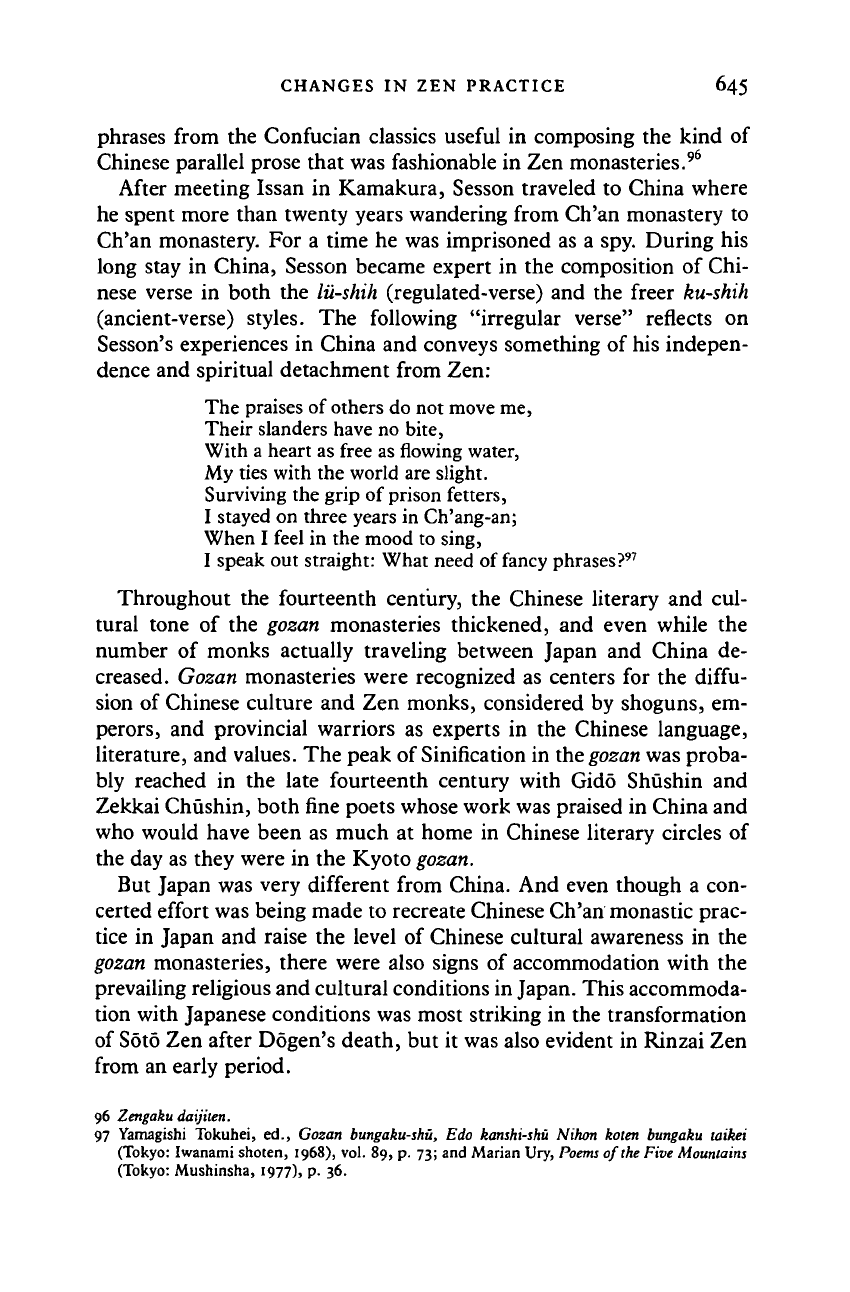
CHANGES IN ZEN PRACTICE 645
phrases from the Confucian classics useful in composing the kind of
Chinese parallel prose that was fashionable in Zen monasteries.
96
After meeting Issan in Kamakura, Sesson traveled to China where
he spent more than twenty years wandering from Ch'an monastery to
Ch'an monastery. For a time he was imprisoned as a spy. During his
long stay in China, Sesson became expert in the composition of Chi-
nese verse in both the lii-shih (regulated-verse) and the freer ku-shih
(ancient-verse) styles. The following "irregular verse" reflects on
Sesson's experiences in China and conveys something of his indepen-
dence and spiritual detachment from Zen:
The praises of others do not move me,
Their slanders have no bite,
With a heart as free as flowing water,
My ties with the world are slight.
Surviving the grip of prison fetters,
I stayed on three years in Ch'ang-an;
When I feel in the mood to sing,
I speak out straight: What need of fancy phrases?
97
Throughout the fourteenth century, the Chinese literary and cul-
tural tone of the gozan monasteries thickened, and even while the
number of monks actually traveling between Japan and China de-
creased. Gozan monasteries were recognized as centers for the diffu-
sion of Chinese culture and Zen monks, considered by shoguns, em-
perors, and provincial warriors as experts in the Chinese language,
literature, and values. The peak of Sinification in the gozan was proba-
bly reached in the late fourteenth century with Gido Shushin and
Zekkai Chushin, both fine poets whose work was praised in China and
who would have been as much at home in Chinese literary circles of
the day as they were in the Kyoto gozan.
But Japan was very different from China. And even though a con-
certed effort was being made to recreate Chinese Ch'an monastic prac-
tice in Japan and raise the level of Chinese cultural awareness in the
gozan monasteries, there were also signs of accommodation with the
prevailing religious and cultural conditions in Japan. This accommoda-
tion with Japanese conditions was most striking in the transformation
of Soto Zen after Dogen's death, but it was also evident in Rinzai Zen
from an early period.
96 Zengaku daijiten.
97 Yamagishi Tokuhei, ed., Gozan bungaku-shu, Edo kanshi-shu Nihon koten bungaku laikei
(Tokyo: Iwanami shoten, 1968), vol. 89, p. 73; and Marian Ury,
Poems
of
the
Five Mountains
(Tokyo: Mushinsha, 1977), p. 36.
Cambridge Histories Online © Cambridge University Press, 2008
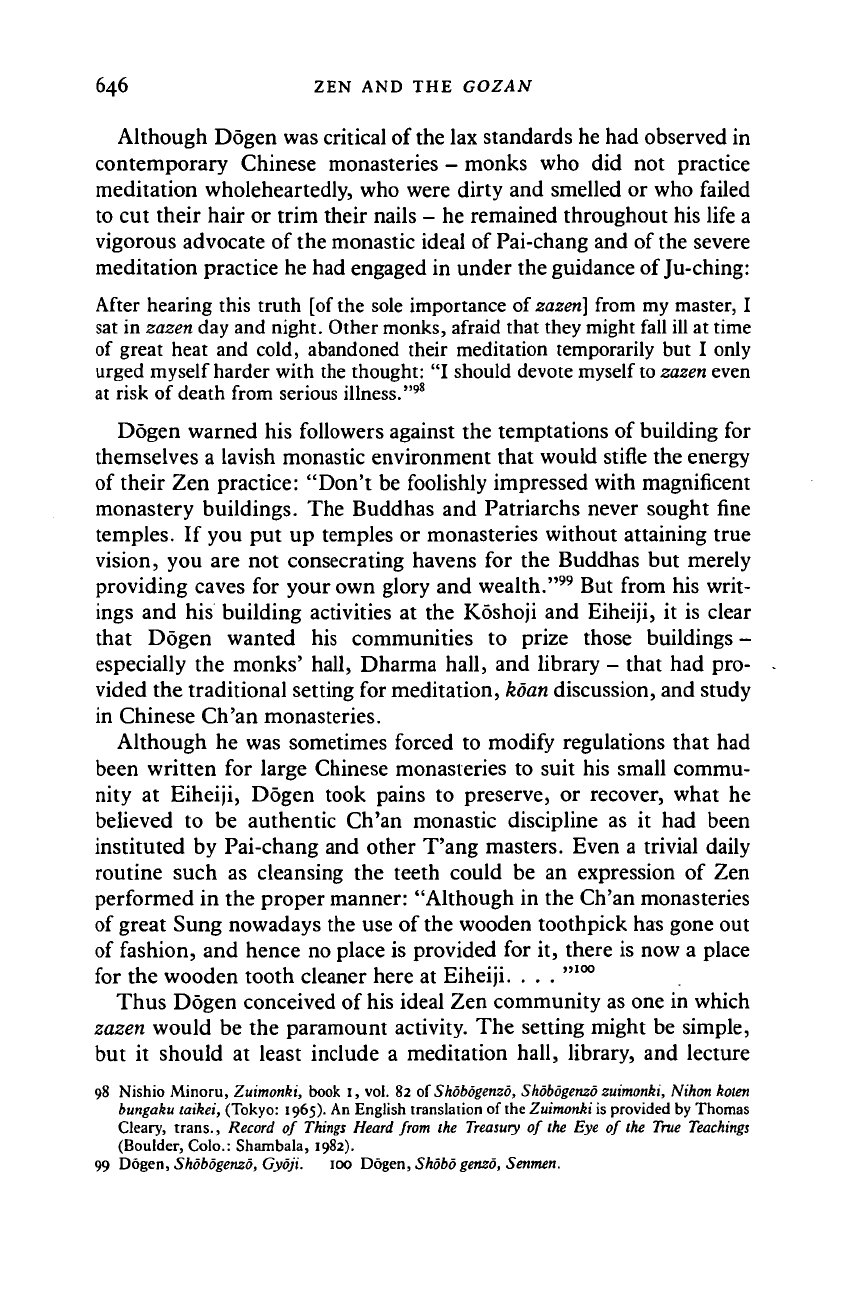
646 ZEN AND THE GOZAN
Although Dogen was critical of the lax standards he had observed in
contemporary Chinese monasteries - monks who did not practice
meditation wholeheartedly, who were dirty and smelled or who failed
to cut their hair or trim their nails - he remained throughout his life a
vigorous advocate of the monastic ideal of Pai-chang and of the severe
meditation practice he had engaged in under the guidance of Ju-ching:
After hearing this truth [of the sole importance of
zazen]
from my master, I
sat in zazen day and night. Other monks, afraid that they might fall ill at time
of great heat and cold, abandoned their meditation temporarily but I only
urged myself harder with the thought: "I should devote myself
to zazen
even
at risk of death from serious illness."'
8
Dogen warned his followers against the temptations of building for
themselves a lavish monastic environment that would stifle the energy
of their Zen practice: "Don't be foolishly impressed with magnificent
monastery buildings. The Buddhas and Patriarchs never sought fine
temples. If you put up temples or monasteries without attaining true
vision, you are not consecrating havens for the Buddhas but merely
providing caves for your own glory and wealth."
99
But from his writ-
ings and his building activities at the Koshoji and Eiheiji, it is clear
that Dogen wanted his communities to prize those buildings -
especially the monks' hall, Dharma hall, and library - that had pro-
vided the traditional setting for meditation, koan discussion, and study
in Chinese Ch'an monasteries.
Although he was sometimes forced to modify regulations that had
been written for large Chinese monasteries to suit his small commu-
nity at Eiheiji, Dogen took pains to preserve, or recover, what he
believed to be authentic Ch'an monastic discipline as it had been
instituted by Pai-chang and other T'ang masters. Even a trivial daily
routine such as cleansing the teeth could be an expression of Zen
performed in the proper manner: "Although in the Ch'an monasteries
of great Sung nowadays the use of the wooden toothpick has gone out
of fashion, and hence no place is provided for it, there is now a place
for the wooden tooth cleaner here at Eiheiji. . . . "
Io
°
Thus Dogen conceived of his ideal Zen community as one in which
zazen would be the paramount activity. The setting might be simple,
but it should at least include a meditation hall, library, and lecture
98 Nishio Minoru, Zuimonki, book I, vol. 82 of Shobogenzo, Shobogenzo zuimonki, Nihon koten
bungaku taikei, (Tokyo: 1965). An English translation of the Zuimonki is provided by Thomas
Geary, trans., Record of Things Heard from the Treasury of ike Eye of the True Teachings
(Boulder, Colo.: Shambala, 1982).
99 Dogen, Shobogenzo, Gyoji. 100 Dogen, Shobo genzo, Senmen.
Cambridge Histories Online © Cambridge University Press, 2008
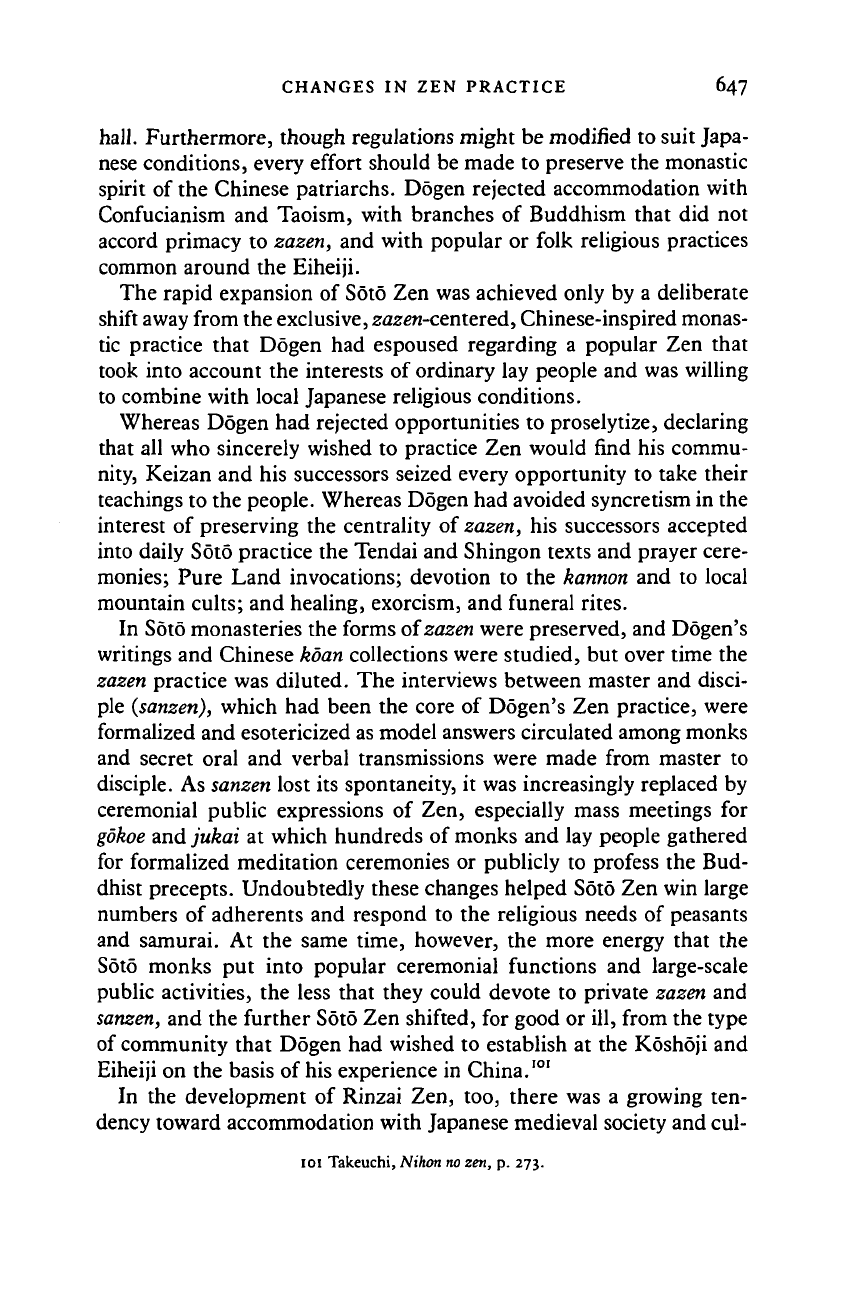
CHANGES IN ZEN PRACTICE 647
hall. Furthermore, though regulations might be modified to suit Japa-
nese conditions, every effort should be made to preserve the monastic
spirit of the Chinese patriarchs. Dogen rejected accommodation with
Confucianism and Taoism, with branches of Buddhism that did not
accord primacy to zazen, and with popular or folk religious practices
common around the Eiheiji.
The rapid expansion of Soto Zen was achieved only by a deliberate
shift away from the exclusive, zazen-centered, Chinese-inspired monas-
tic practice that Dogen had espoused regarding a popular Zen that
took into account the interests of ordinary lay people and was willing
to combine with local Japanese religious conditions.
Whereas Dogen had rejected opportunities to proselytize, declaring
that all who sincerely wished to practice Zen would find his commu-
nity, Keizan and his successors seized every opportunity to take their
teachings to the people. Whereas Dogen had avoided syncretism in the
interest of preserving the centrality of zazen, his successors accepted
into daily Soto practice the Tendai and Shingon texts and prayer cere-
monies; Pure Land invocations; devotion to the kannon and to local
mountain cults; and healing, exorcism, and funeral rites.
In Soto monasteries the forms of zazen were preserved, and Dogen's
writings and Chinese koan collections were studied, but over time the
zazen practice was diluted. The interviews between master and disci-
ple {sanzen), which had been the core of Dogen's Zen practice, were
formalized and esotericized as model answers circulated among monks
and secret oral and verbal transmissions were made from master to
disciple. As sanzen lost its spontaneity, it was increasingly replaced by
ceremonial public expressions of Zen, especially mass meetings for
gokoe and jukai at which hundreds of monks and lay people gathered
for formalized meditation ceremonies or publicly to profess the Bud-
dhist precepts. Undoubtedly these changes helped Soto Zen win large
numbers of adherents and respond to the religious needs of peasants
and samurai. At the same time, however, the more energy that the
Soto monks put into popular ceremonial functions and large-scale
public activities, the less that they could devote to private zazen and
sanzen, and the further Soto Zen shifted, for good or ill, from the type
of community that Dogen had wished to establish at the Koshoji and
Eiheiji on the basis of his experience in China.
101
In the development of Rinzai Zen, too, there was a growing ten-
dency toward accommodation with Japanese medieval society and cul-
101 Takeuchi, Nihon no zen, p. 273.
Cambridge Histories Online © Cambridge University Press, 2008
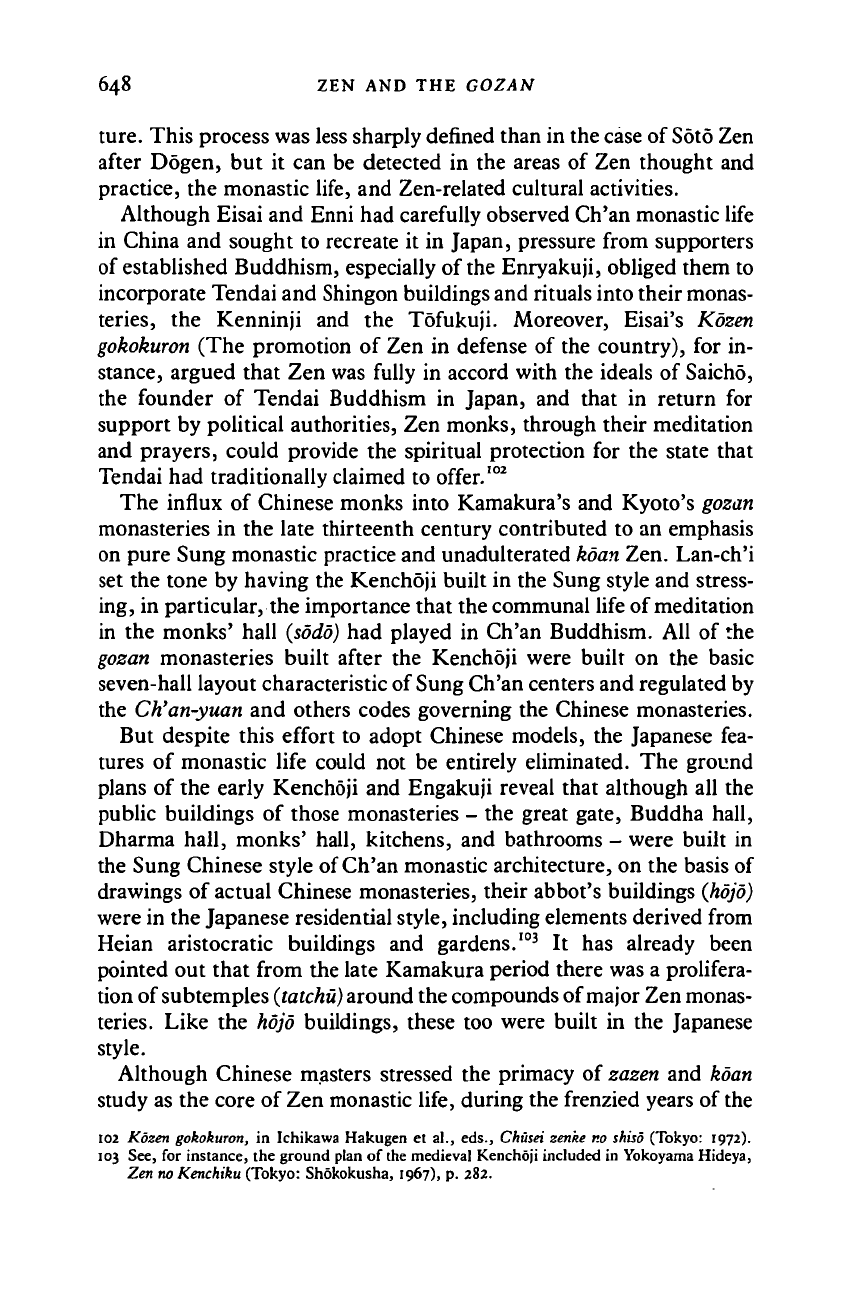
648 ZEN AND THE GOZAN
ture.
This process was less sharply defined than in the case of
Soto
Zen
after Dogen, but it can be detected in the areas of Zen thought and
practice, the monastic life, and Zen-related cultural activities.
Although Eisai and Enni had carefully observed Ch'an monastic life
in China and sought to recreate it in Japan, pressure from supporters
of established Buddhism, especially of the Enryakuji, obliged them to
incorporate Tendai and Shingon buildings and rituals into their monas-
teries,
the Kenninji and the Tofukuji. Moreover, Eisai's Kozen
gokokuron
(The promotion of Zen in defense of the country), for in-
stance, argued that Zen was fully in accord with the ideals of Saicho,
the founder of Tendai Buddhism in Japan, and that in return for
support by political authorities, Zen monks, through their meditation
and prayers, could provide the spiritual protection for the state that
Tendai had traditionally claimed to offer.
102
The influx of Chinese monks into Kamakura's and Kyoto's
gozan
monasteries in the late thirteenth century contributed to an emphasis
on pure Sung monastic practice and unadulterated
koan
Zen. Lan-ch'i
set the tone by having the Kenchoji built in the Sung style and stress-
ing, in particular, the importance that the communal life of meditation
in the monks' hall
(sddo)
had played in Ch'an Buddhism. All of the
gozan monasteries built after the Kenchoji were built on the basic
seven-hall layout characteristic of Sung Ch'an centers and regulated by
the Ch'an-yuan and others codes governing the Chinese monasteries.
But despite this effort to adopt Chinese models, the Japanese fea-
tures of monastic life could not be entirely eliminated. The ground
plans of the early Kenchoji and Engakuji reveal that although all the
public buildings of those monasteries - the great gate, Buddha hall,
Dharma hall, monks' hall, kitchens, and bathrooms - were built in
the Sung Chinese style of Ch'an monastic architecture, on the basis of
drawings of actual Chinese monasteries, their abbot's buildings
(hojo)
were in the Japanese residential style, including elements derived from
Heian aristocratic buildings and gardens.
103
It has already been
pointed out that from the late Kamakura period there was a prolifera-
tion of subtemples
(tatchu)
around the compounds of major Zen monas-
teries.
Like the hojo buildings, these too were built in the Japanese
style.
Although Chinese masters stressed the primacy of
zazen
and koan
study as the core of Zen monastic life, during the frenzied years of the
102
Kozen gokokuron, in Ichikawa Hakugen et al., eds., Chusei zenke no shiso (Tokyo: 1972).
103
See, for instance, the ground plan of the medieval Kenchoji included in Yokoyama Hideya,
Zen no
Kenchiku (Tokyo: Shokokusha, 1967), p. 282.
Cambridge Histories Online © Cambridge University Press, 2008
